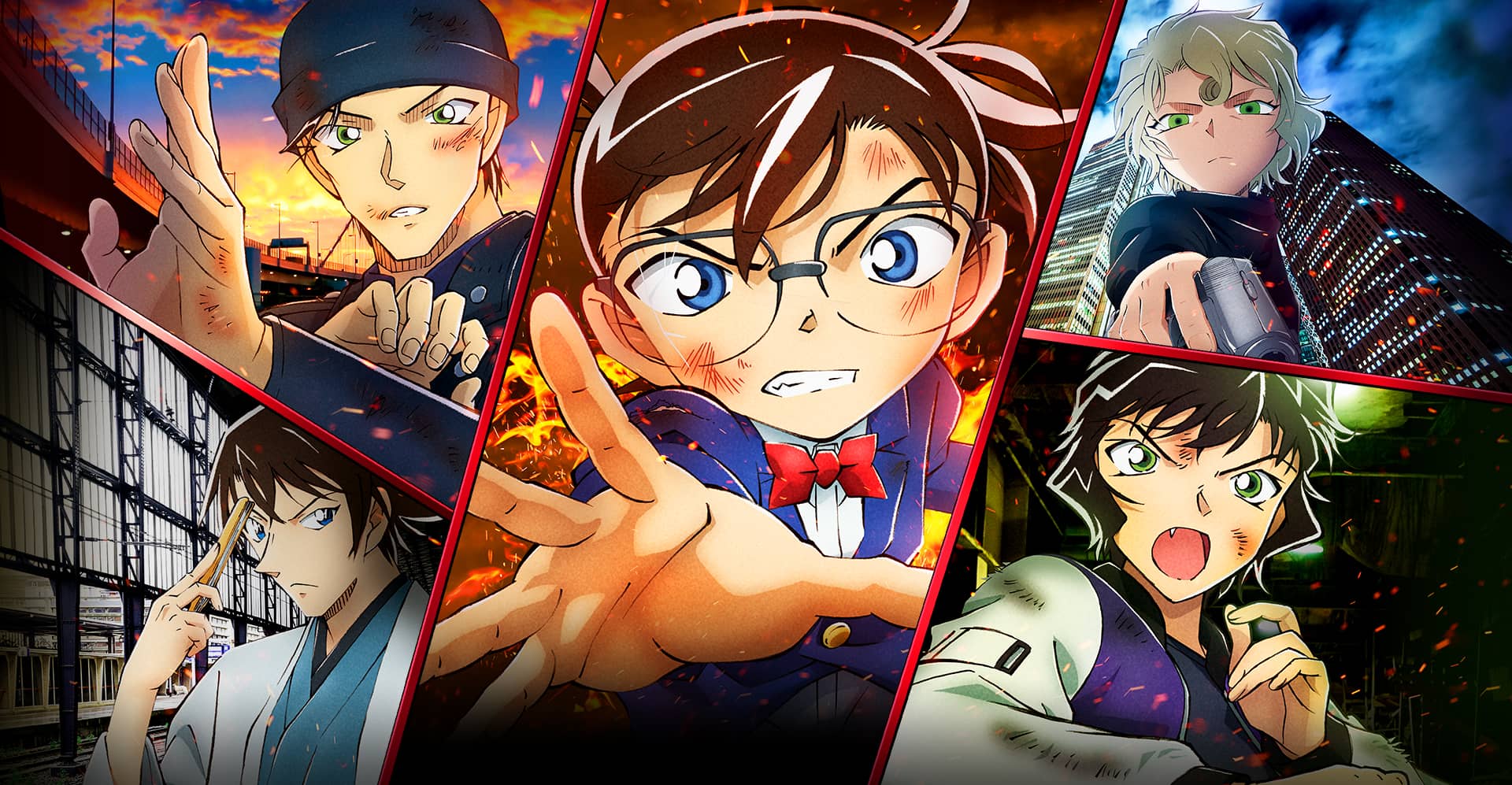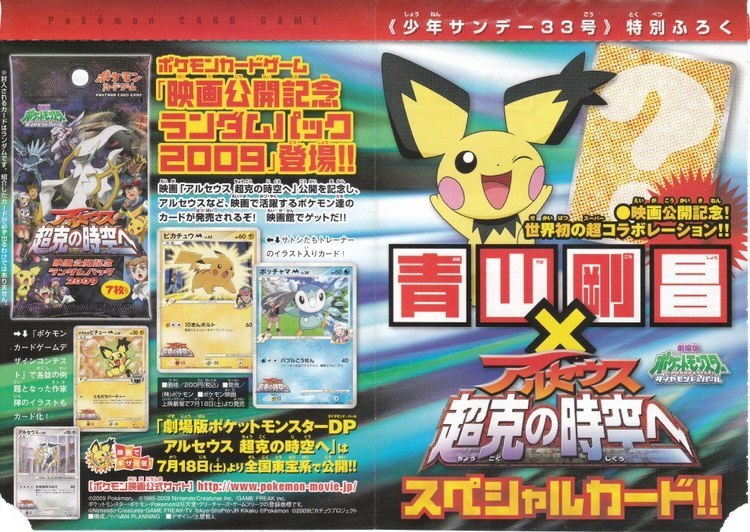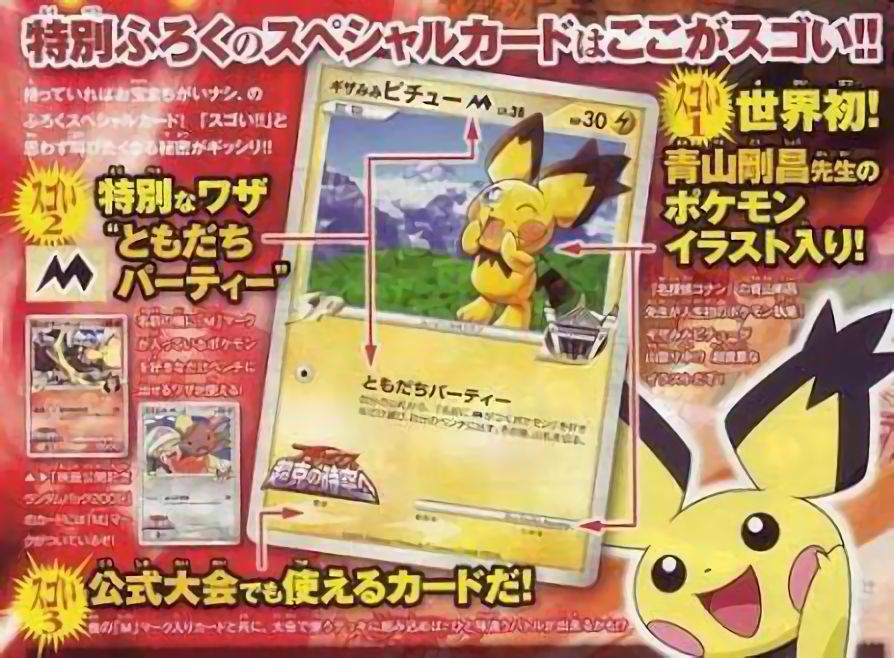042/DPt-P - Sapphire in a Bag of Diamonds
At its top level the 2009 Pokémon Card Design Contest is made up of 7 winning Arceus designs and 6 winning Pichu designs. Some people out there believe the 042/DPt-P Pichu is a 7th winning Pichu design — but is it?
Table of Contents

Introduction
On 26th July 2009 the Illustration contests page was added to Bulbapedia, listing all the cards known to have originated from various officially-organised design contests to have run up to that point.[1]
Alongside the 1997 CoroCoro Illustration Contest, 1999 Pokémon Snap Contest and 2005 WB Creator Contest was a section for the then recently-completed Twelfth Movie Illustration Contest - more commonly known today as the 2009 Pokémon Card Design Contest.
This section included a table listing the 13 winning contest designs along with 3 Arceus and 3 Pichu cards from the Movie Commemoration Random Pack and an entry for the 042/DPt-P Pichu.
By 22nd October 2011 the Bulbapedia article had been updated to include images of all of the cards known to exist from all illustration contests. The 6 Random Pack cards were no longer included, but the 042/DPt-P Pichu card was still there: it was displayed in-between the 13 winning 2009 Design Contest cards with a new caption of “Weekly Shonen Sunday winner”.[2]
Almost 12 years on from the card’s release, PSA has now graded 17 copies of this card. All of these have featured alongside the other 2009 design contest-winning cards in PSA’s 2009 Pokemon Japanese Design Contest Promo set with a description of “Shonen Sunday Magazine Winner”.[3]
On 16th June 2020 - after having been in place for over 8 years - I removed the 042/DPt-P card from Bulbapedia’s Illustration contests. But if it isn’t part of the 2009 Pokémon Card Design Contest… where is it from?
What is Weekly Shōnen Sunday?
Weekly Shōnen Sunday is one of many different shōnen manga magazines - Japanese magazines featuring comics primarily aimed at boys between the ages of 12 and 18. It first launched in 1959 and is still being produced today, 61 years later.
Despite having Sunday in the name, until 2011 these were released on Tuesdays (and since then they’ve been released on Wednesdays instead).
In June 2009, with an average weekly circulation of 773,062, it was the third most popular shōnen manga magazine in Japan.[4]

Unlike the two larger publications, Weekly Shōnen Jump and Weekly Shōnen Magazine, Weekly Shōnen Sunday is published by Shogakukan - the same publishing house responsible for the thirteen 2009 Pokémon Card Design Contest magazines.
The 2009 issue 33 pictured above was released on Tuesday 23rd June 2009, 5 days after the winners of the 2009 Design Contest had been announced on the same day of the theatrical release of Arceus and the Jewel of Life (アルセウス 超克の時空へ) in Japan.
It’s easy to see how the lines became blurred between this card and the thirteen winning design contest cards, with not only five days between their release, but also being a Shogakukan magazine release featuring unusual artwork by an unfamiliar Pokémon illustrator: Gōshō Aoyama.
Who is Gōshō Aoyama?
Born in 1963, Gōshō Aoyama (青山 剛昌) studied at the Nihon University College of Art in Tokyo and made his debut as a manga artist with Chotto Mattete in 1987, published in none other than Weekly Shōnen Sunday.[5]
On 19th January 1994 the first instalment of Aoyama’s Detective Conan (Case Closed) manga series was published by Weekly Shōnen Sunday. 98 manga volumes and over 1,000 anime episodes later, Detective Conan is still going strong today. The 24th Detective Conan movie, The Scarlet Bullet, is scheduled to be released in Japanese theatres next month.

As a wonderful and mostly unknown crossover, Gōshō Aoyama is the illustrator of the 042/DPt-P Pichu.
How was the card distributed?
Earlier in this article I mentioned that PSA have graded 17 copies of this card. Comparing this figure to that of the 2009 Design Contest-winning cards which only had 100 copies of each distributed that PSA have graded between 3 and 5 of, you could come to a pretty hasty conclusion that these 042/DPt-P Pichu cards are still pretty rare cards with a low distribution number.
You’d be very wrong.

This Pichu card was included as an appendix insert in the 2009 issue 33 of Weekly Shōnen Sunday. This means that every copy of the magazine to be distributed also had the 042/DPt-P Pichu card inside.
If you’ve been paying very close attention up to this point your jaw may now be very close to the floor - on average in June 2009, 773,062 of these magazines were distributed and sold weekly throughout Japan. That is to say that over 750,000 of these Pichu cards were printed and included in Weekly Shōnen Sunday magazine inserts.
According to popular TCG marketplace website Troll & Toad, Pokémon cards have a height of 3.5 inches (88.9mm), a width of 2.5 inches (63.5mm), a depth of 0.012 inches (0.3mm) and a weight of 0.004 pounds (1.8 grams).[6] Double-decker buses in the UK are typically around 12 metres in length, 2.55 metres in width and 4.95 metres in height.[7] We can use this to paint a picture of just how many 042/DPt-P Pichu cards were printed:
- At 225 metres, in a pile the tower of 750,000 Pichu cards would be taller than 45 double-decker buses stacked on top of each other;
- At 47.6 kilometres, 18,670 double-decker buses could park side-by-side along the line each card placed side-by-side would take up;
- At 66.7 kilometres, each card placed top-to-bottom is equivalent to over 5,550 double-decker buses back-to-back (definitely not a queue I’d want to be stuck in).
Despite all this, the 750,000 cards would only take up roughly 1.27 cubic metres of space, meaning a single double-decker bus with a volume of 112.5 cubic metres[8] could easily fit the 1.36 metric tonne block of cards.
I appreciate that those of you outside of the UK may not use double-decker buses as a standard unit of measurement, so if that’s still a bit too difficult to visualise here is an image of 750,000 10px by 10px squares (you may need to zoom in). Each square represents one 042/DPt-P Pichu card and each row represents 100 of those cards.

If there’s any doubt in anyone’s mind that the name Gōshō Aoyama could just be a coincidence, a write-up inside the magazine about the Pichu highlights that it is illustrated by the “world famous manga artist”.
Sharing the same Friend Party (ともだちパーティー) move that the 13 design contest-winning cards and 3 Random Pack Pichu cards also have - the purpose of the move is to allow you to find any Pokémon with the movie mark “M” in your deck to add to your bench - this page mentions that the 042/DPt-P Pichu is tournament legal.
Many thanks to Slemno for helping me translate this page.
Conclusion
Whilst the 042/DPt-P Pichu card was Shogakukan magazine-related and features unusual artwork from an unfamiliar illustrator, it is not one of the 2009 Pokémon Card Design Contest winning cards - its association is purely coincidental. However it is a wonderfully overlooked collaboration.
I wasn’t able to uncover any information as to why the card came to be, but I can only assume it was a commissioned piece by Pokémon or Shogakukan as a promotion to accompany the Arceus and the Jewel of Life movie.
I hope going forward fewer people will continue to associate this card with the 2009 Design Contest and more people will learn of it as a fantastic piece of artwork by a very well-respected and qualified manga artist.
Whilst an estimated distribution of 773,062 cards does sound like an awful lot, it pales in comparison to the distribution numbers of some of the most beloved cards in the hobby.
It may not be a diamond, but it’s a gem in its own right.
References
- bulbapedia.bulbagarden.net. 26th July 2009. Illustration contests - Revision as of 04:14, 26 July 2009 by Maverick Nate [online] Available at: https://bulbapedia.bulbagarden.net/w/index.php?title=Illustration_contests&oldid=814430 [Accessed 11th March 2021]
- bulbapedia.bulbagarden.net. 22nd October 2011. Difference between revisions of "Illustration contests": 27 August 2010 and 22 October 2011 [online] Available at: https://bulbapedia.bulbagarden.net/w/index.php?title=Illustration_contests&diff=1534328&oldid=1168638 [Accessed 11th March 2021]
- psacard.com. 11th March 2021. 2009 Pokemon Japanese Design Contest Promo - Population Report [online] Available at: https://www.psacard.com/pop/tcg-cards/2009/pokemon-japanese-design-contest-promo/109046 [Accessed 11th March 2021]
- animenewsnetwork.com. 18th January 2010. 2009 Japanese Manga Magazine Circulation Numbers [online] Available at: https://www.animenewsnetwork.com/news/2010-01-18/2009-japanese-manga-magazine-circulation-numbers [Accessed 11th March 2021]
- en.wikipedia.org. 24th December 2020. Gosho Aoyama [online] Available at: https://en.wikipedia.org/wiki/Gosho_Aoyama [Accessed 12th March 2020]
- trollandtoad.com. 10th March 2021. Butterfree - 33/64 - Uncommon Unlimited [online] Available at: https://www.trollandtoad.com/pokemon/jungle-unlimited-singles/butterfree-33-64-uncommon-unlimited/148906 [Accessed 11th March 2021]
- en.wikipedia.org. 10th March 2021. Double-decker bus [online] Available at: https://en.wikipedia.org/wiki/Double-decker_bus#United_Kingdom [Accessed 11th March 2021]
- busdriving.blogspot.com. 3rd August 2006. Double Decker Buses and Swimming Pools [online] Available at: http://busdriving.blogspot.com/2006/08/double-decker-buses-and-swimming-pools.html [Accessed 12th March 2020]